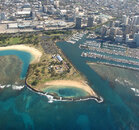Dr. Lecter
Contributor
SB already contains a fair number of posts addressing the hypothetical advantages of the long primary/necklace secondary regulator configuration. I thought I would offer the events of last night's dive as an example of just how valuable the bungied octo can be.
I and my buddy planned a 4pm shore dive off Honolulu's Magic Island lagoon, but it wound up being a 5:45pm dive. No worries, we had the lights and navigational equipment for a night dive... so ahead we went. As usual, we entered the water at the lagoon and then headed out into the ocean through the second cut in the breakwater. This has substantial overlap between the sides of the breakwater, providing protection from the waves.

We dropped under and swam out through the cut without incident, regrouped far enough away from the breakwater to not get tossed onto it by the significant but not unmanagable surf, and descended to do our dive. The light was fading when we headed out, but within 10 minutes it was fully dark. At our turn point, we decided to ascend to take a compass bearing on the breakwater since even around 40' we had experienced significant surge and a cross current. At the surface, we found our bearing and decided to conduct a surface swim to conserve gas for the dive back through the breakwater, as the surf was looking worse than when we left.
Near the breakwater, the surf was much worse than when we left. We shot a last bearing for the cut we wanted, dropped down, and swam for it hard. My buddy made it in, but between the surge pushing and tumbling me, the bubbles destroying the viz, and the dark, I missed the cut and the next breaker tossed me up and dropped me down onto the rocks. Landing belly first with double 130s on my back wasn't what I'd call fun, but then the next wave knocked me off the rocks and into the cut.
My reg got knocked out of my mouth and off around my neck while I was tumbling around in the spin cycle. Finding it at the end of the long hose while holding onto my light wasn't something I felt I had time to do--the conditions were just too violent to pause. Coming up for air wasn't an option for the same reasons, plus I was heavily negative to fight the surge's effect. Knowing exactly where it was under my chin, I quickly reached up and pushed the bungied octo into my mouth, and moved forward as fast as I could into the safety of the lagoon.
Lesson learned (among others): there may come a time when you find yourself in rougher conditions than you expected, and having a secured secondary regulator right where you need it can save your life when that happens.
I and my buddy planned a 4pm shore dive off Honolulu's Magic Island lagoon, but it wound up being a 5:45pm dive. No worries, we had the lights and navigational equipment for a night dive... so ahead we went. As usual, we entered the water at the lagoon and then headed out into the ocean through the second cut in the breakwater. This has substantial overlap between the sides of the breakwater, providing protection from the waves.

We dropped under and swam out through the cut without incident, regrouped far enough away from the breakwater to not get tossed onto it by the significant but not unmanagable surf, and descended to do our dive. The light was fading when we headed out, but within 10 minutes it was fully dark. At our turn point, we decided to ascend to take a compass bearing on the breakwater since even around 40' we had experienced significant surge and a cross current. At the surface, we found our bearing and decided to conduct a surface swim to conserve gas for the dive back through the breakwater, as the surf was looking worse than when we left.
Near the breakwater, the surf was much worse than when we left. We shot a last bearing for the cut we wanted, dropped down, and swam for it hard. My buddy made it in, but between the surge pushing and tumbling me, the bubbles destroying the viz, and the dark, I missed the cut and the next breaker tossed me up and dropped me down onto the rocks. Landing belly first with double 130s on my back wasn't what I'd call fun, but then the next wave knocked me off the rocks and into the cut.
My reg got knocked out of my mouth and off around my neck while I was tumbling around in the spin cycle. Finding it at the end of the long hose while holding onto my light wasn't something I felt I had time to do--the conditions were just too violent to pause. Coming up for air wasn't an option for the same reasons, plus I was heavily negative to fight the surge's effect. Knowing exactly where it was under my chin, I quickly reached up and pushed the bungied octo into my mouth, and moved forward as fast as I could into the safety of the lagoon.
Lesson learned (among others): there may come a time when you find yourself in rougher conditions than you expected, and having a secured secondary regulator right where you need it can save your life when that happens.




